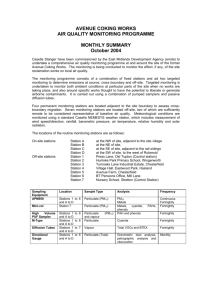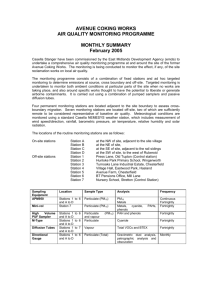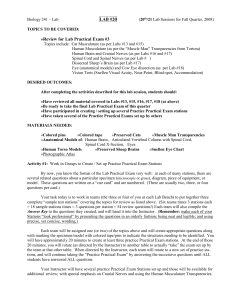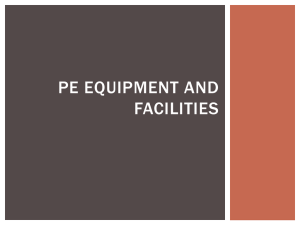September 2004 - The Avenue Coking Works Regeneration Project
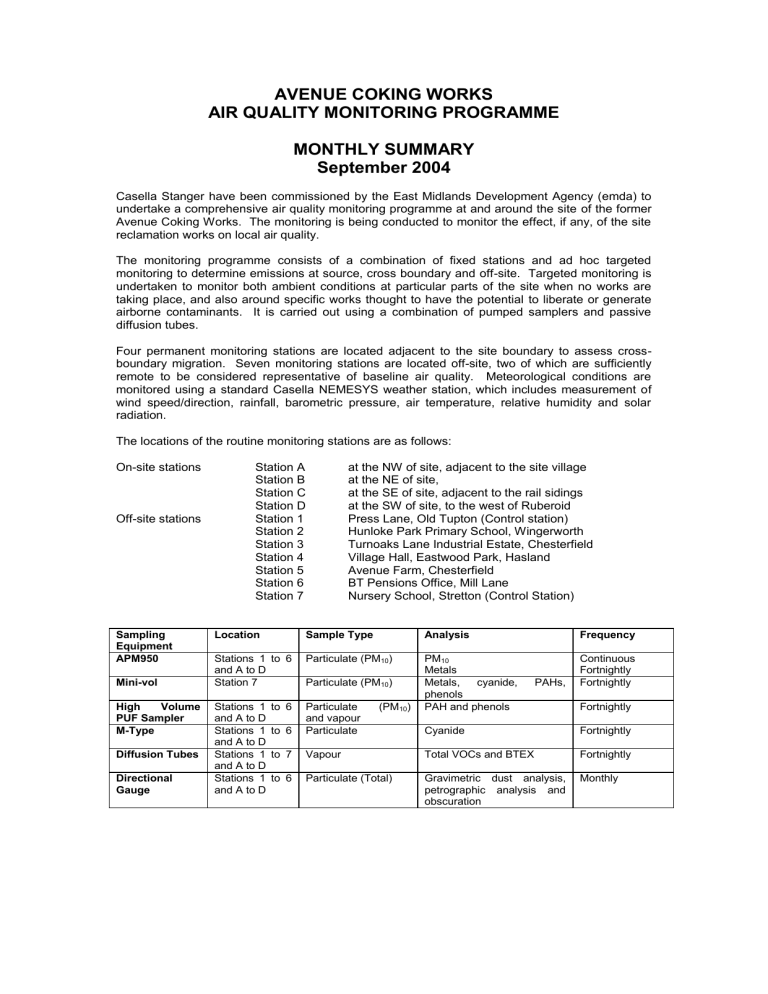
AVENUE COKING WORKS
AIR QUALITY MONITORING PROGRAMME
MONTHLY SUMMARY
September 2004
Casella Stanger have been commissioned by the East Midlands Development Agency (emda) to undertake a comprehensive air quality monitoring programme at and around the site of the former
Avenue Coking Works. The monitoring is being conducted to monitor the effect, if any, of the site reclamation works on local air quality.
The monitoring programme consists of a combination of fixed stations and ad hoc targeted monitoring to determine emissions at source, cross boundary and off-site. Targeted monitoring is undertaken to monitor both ambient conditions at particular parts of the site when no works are taking place, and also around specific works thought to have the potential to liberate or generate airborne contaminants. It is carried out using a combination of pumped samplers and passive diffusion tubes.
Four permanent monitoring stations are located adjacent to the site boundary to assess crossboundary migration. Seven monitoring stations are located off-site, two of which are sufficiently remote to be considered representative of baseline air quality. Meteorological conditions are monitored using a standard Casella NEMESYS weather station, which includes measurement of wind speed/direction, rainfall, barometric pressure, air temperature, relative humidity and solar radiation.
The locations of the routine monitoring stations are as follows:
On-site stations Station A at the NW of site, adjacent to the site village
Off-site stations
Station B
Station C
Station D
Station 1
Station 2
Station 3
Station 4
Station 5
Station 6
Station 7 at the NE of site, at the SE of site, adjacent to the rail sidings at the SW of site, to the west of Ruberoid
Press Lane, Old Tupton (Control station)
Hunloke Park Primary School, Wingerworth
Turnoaks Lane Industrial Estate, Chesterfield
Village Hall, Eastwood Park, Hasland
Avenue Farm, Chesterfield
BT Pensions Office, Mill Lane
Nursery School, Stretton (Control Station)
Sampling
Equipment
APM950
Mini-vol
Location
Stations 1 to 6 and A to D
Station 7
Sample Type
Particulate (PM
10
)
Particulate (PM
10
)
Analysis
PM
10
Metals
Metals, cyanide, PAHs, phenols
PAH and phenols
Frequency
Continuous
Fortnightly
Fortnightly
Fortnightly High Volume
PUF Sampler
M-Type
Stations 1 to 6 and A to D
Stations 1 to 6 and A to D
Diffusion Tubes Stations 1 to 7 and A to D
Directional
Gauge
Stations 1 to 6 and A to D
Particulate (PM
10
) and vapour
Particulate
Vapour
Particulate (Total)
Cyanide
Total VOCs and BTEX
Gravimetric dust analysis, petrographic analysis and obscuration
Fortnightly
Fortnightly
Monthly
RESULTS FOR SEPTEMBER 2004
The results have been evaluated by comparison with the assessment criteria developed in the
Babtie report 'The Avenue Air Quality Management Programme Strategy Document' Issue 1, June
2002.
1.0
1.1
ROUTINE AIR MONITORING PROGRAMME
Alterations, Downtime and Technical Difficulties
The Local Authority are working with Jacobs Babtie to find a suitable alternative location for station 3 equipment which was removed from the Cricket Club in September 2001.
The APM950 unit at station 6 ceased operating on 5 September and was restarted on 6
September; this was assumed to be due to a power cut. No data was collected for this period.
The APM950 units at stations C and D stopped sampling on 15 September and were restarted on 17 September; as the faults occurred at the same time they are thought to be due to a power cut. The units are now checked on a regular basis and no further data losses have occurred.
The M-Type sampler pump at station AA was found to be faulty during the first monitoring period of the month, and the sample was therefore lost. The equipment was repaired and recommissioned on 16 September, and the period 2 data collected as normal.
The Hi-vol sampler pump at station 5 failed during the second monitoring period and that sample was therefore lost. The unit was repaired and a checking routine implemented.
1.2 PM
10
Levels
No on- or off-site stations recorded concentrations of PM
10
above the assessment criteria of 50
µg/m 3 per day at any stage during September 2004.
1.3 Metals
The only metal currently falling under the control of the UK Air Quality Strategy is lead, at a maximum concentration 0.5
g/m 3 (quoted as an annual mean). Lead concentrations at all on and off-site stations were recorded below this objective; the maximum level of lead recorded at any of the stations was 0.0132
g/m 3 , which represents a fortnightly total.
Of the other metals monitored, copper and zinc were found at the highest concentrations at all stations (max copper = 0.2144
g/m 3 , max zinc = 0.0317
g/m 3 ).
All metals were below the assessment criteria developed for The Avenue site
1.4 Cyanide
No National Air Quality Standard has been developed for cyanide; the assessment criteria suggested for the Avenue is a maximum concentration of 120 µg/m 3 per fortnight. The maximum concentration recorded on-site was 0.0133
g/m 3 at station D during the first monitoring period; the maximum recorded off-site was 0.0107
g/m 3 at both stations 1 and 7 during the first monitoring period.
1.5 Phenol(s)
The assessment criteria limits for phenol and cresol are 48µg/m 3 and 525µg/m 3 respectively. per fortnight,
As detailed below, the reporting of phenols is now subject to a limit of detection (LOD) of 0.2
g/m 3 ; no results were reported at or above this level.
1.6 PAHs
The maximum allowable fortnightly concentration of Coal Tar Pitch Volatiles is 0.480µg/m 3 , and for naphthalene is 126.0 µg/m 3 . None of the on or off-site stations recorded concentrations which exceeded these criteria. The highest recorded concentration of Total Coal Tar Pitch Volatiles was
0.1054 µg/m 3 , at station D during the first period.
1.7 BTEX Compounds
The assessment cri teria limits for benzene and toluene are 23 µg/m 3 and 10.5 mg/m 3 per fortnight, respectively.
The highest recorded benzene result in August 2004 was 0.0089 mg/m 3 , at station 4 during the first period; all other results were below detection limits. The maximum toluene concentration was
0.0304 mg/m 3 at station 6 during the first period.
1.8 Directional Gauge Results
The Avenue Air Monitoring Programme - Dust Deposition at all Locations
September 2004
140.00
120.00
100.00
80.00
60.00
40.00
North
South
East
West
20.00
0.00
A
B
C
D
1
Monitoring Station
2
4
5
West
East
South
North
6
The Directional Dust Gauge result for station 6 was 249.82 mg/m 2 /day, exceeding the assessment criterion level of 200 mg/m 2 /day. Distribution of the dust was very uneven with 4.5% from the north, 54% from the south, 33.5% from the east and 8% from the west. Petrographic analysis of the dust indicates that that collected from the north comprised 48% amorphous dirt, 15% each of silicon rich material and unburnt coal (includes 2% carbonised coal), 12% calcium rich material, and 5% each of plant and animal fragments and iron rich material; from the south the dust comprised 38% unburnt coal, 18% amorphous dirt, 17% calcium rich material, 15% silicon rich material, and 2% iron rich material.
Although the prevailing wind during the month was from the direction of the site (northnorthwesterly), only a small proportion of the dust was collected from this direction, suggesting that the Avenue was not the primary source of the elevated dust levels.
2.0 QUALITY CONTROL SAMPLES
Quality control samples were submitted in the form of duplicates for all sample media and blanks for phenols, cyanide, metals, PAHs and BTEX.
2.1 Media Blanks
As reported previously, to address the issue of the apparent contamination of media used for the sampling and analysis of phenols, reporting of results is now done on the basis of a limit of detection of 0.2 µg/m 3 . Despite this, however, the analysis of media blanks identified some crosscontamination associated with sampling and analysis of phenols, with the mass of phenol recorded on the two blanks measured at 6 and 3400 µg, whereas the maximum mass measured on field media was 7 µg.
Analysis of media blanks (unexposed filters) used to collect samples of BTEX has identified significant contamination in results for toluene and Total VOCs over recent months. In September
one of the two blanks registered a reading of 160 ng for toluene and 160 ng for Total VOCs, compared to results of <50 to 250 ng and <50 to 1800 ng respectively obtained from field media.
In an effort to investigate and address these contamination issues Casella Stanger undertook an audit of both their own and their laboratory’s procedures on 18 and 19 August. The main findings of this report were that some deficiencies were present in the labelling, general handling and chain of custody procedures with respect to sampling media. Casella have implemented corrective actions to address various internal deficiencies, and requested that SAL do likewise. SAL have responded to the effect that some tightening of their procedures is taking place, but Casella are currently seeking further assurances.
2.2 Duplicates
Duplicate PM
10 samples taken at station A correlated well with original data over the whole monitoring period.
Duplicate PAH results from station 1 correlated well with original data over both periods. The only exceptions were the first period duplicate acenaphthene and anthracene results, which were less than half and more than twice original results respectively.
No phenols results were reported above the new LOD of 0.2 µg/m 3 . As a result duplicate results from station 1 correlated exactly with original results over both periods.
Duplicate cyanide results taken at station A correlated relatively well with original samples over both periods.
Duplicate metals results from station A displayed very good correlation with original results in both periods.
Duplicate results for speciated VOCs correlated moderately well with original data for station 6 during both periods. The exceptions in the first period were toluene and total VOCs, which were only 30% and 10% of original result respectively, and total VOCs in the second period, which was less than a fifth of the original result.
3.0 TARGETED AIR MONITORING PROGRAMME
Targeted monitoring is generally undertaken around specific site activities considered to have the potential to liberate airborne contaminants, and also to monitor ambient conditions when no works are taking place. Due to the lack of activities considered to have the potential to generate or liberate contaminants, however, no targeted monitoring was undertaken during this month.
